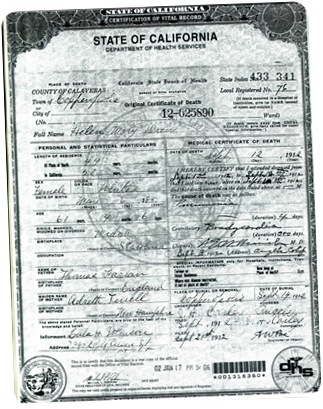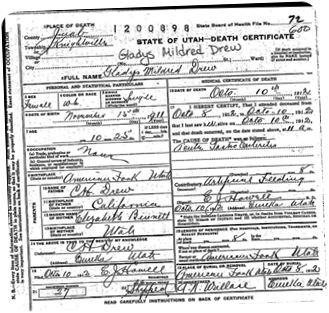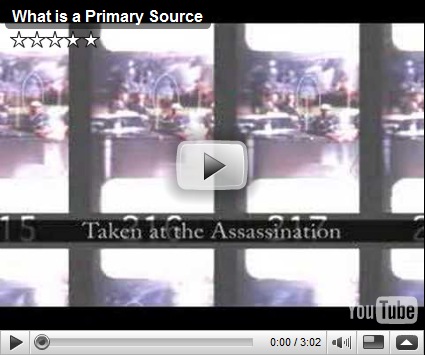We know that primary source documents always are desired to assist in proving our lineage. Can we count on their accuracy?
 The answer is NO. They frequently contain errors. Dates are wrong. Locations are frequently wrong. Names are wrong or misspelled. Why does this happen?
The answer is NO. They frequently contain errors. Dates are wrong. Locations are frequently wrong. Names are wrong or misspelled. Why does this happen?
Looking at my great grandmother’s death certificate, I immediately noticed that her name was different than the one written in various publications and family records.
Great Grandma’s birth name was “Helen Marr Farrar”, yet the name listed on the certificate is “Helen Mary Drew”. Did the recorder hear the information wrong or accidentally write a name frequently used in his family?
That is one possibility. I make the same error at times. However, her certificate offers a greater clue to the problem. The informant listed on the certificate is "Lula H. Johnson”. For some reason, great grandma’s death information was given to authorities by her niece rather than by any of her six children that lived in the area.
Can you provide the full birth name, birth date and parents names for your aunts and uncles from memory? Not many of us can. Lula, was probably helping the family take care of ‘foot work’ while the children arranged the funeral, burial and mourned the loss of their mother.
We know that the birth information listed on a death certificate is suspect. It came from someone’s memory. The only facts that should be correct on the certificate are the name, death date and place and burial date and place and yet, even they are ‘suspect’.
The birth information and even the parents names on death certificates are secondary sources at best.
One of the key indicators that grandma’s name was Helen Marr was a letter from her “family historian” granddaughter that states that great grandma was named after her mothers sister, Helen Marr Tirrill.
Wondering if “Marr” was a rare name in that day, I searched for others that may have had the name and was surprised how frequently it was used. A misspelling was undoubtedly less of a factor than I initially suspected.
Errors abound in the birth and death certificates that I’ve found for my family. In fact, they are more common than not.
My aunt died as a young child in the now non-existent town of Knightsville, Utah. My grandparents lived in the area when grandpa had a wagon and horse team hauling supplies and anything else needed between Salt Lake City and the remote mining towns in Juab county.
 The informant listed on Gladys’ certificate was my grandfather but unfortunately, the registrar, Mr. E. J. Howell incorrectly recorded her burial location. It states that aunt Gladys was buried in the American Fork, Utah cemetery, yet she and her baby sister are actually buried side-by-side in the family plot in the Alpine cemetery.
The informant listed on Gladys’ certificate was my grandfather but unfortunately, the registrar, Mr. E. J. Howell incorrectly recorded her burial location. It states that aunt Gladys was buried in the American Fork, Utah cemetery, yet she and her baby sister are actually buried side-by-side in the family plot in the Alpine cemetery.
Was she initially buried in American Fork and later moved to Alpine? No. Her uncle Charles and aunt Ada were buried on the plot in 1901 and 1904 respectively. Two other aunts and an uncle died as babies and were buried on the family farm in the late 1880’s – early 1890’s, so the family didn’t own the cemetery plot then, but by the time their eldest son was buried in 1901, they owned or had purchased the lot.
Gladys was buried in Alpine not in American Fork. The “primary source” information on her death certificate is wrong.
I wonder how many errors exist in the thousands of certificate that that I’ve collected over the years yet don’t have enough other information to cause me to suspect errors in them. There are probably quite a few, but since I know that even “Primary” source documents frequently contain errors, I still list them in my databases with the highest level of confidence. What else can be considered a “Primary Source Document”?
You have the same problem in your own source documents. Don’t let it throw you. Don’t obstinately argue over minor factual differences with other researchers. Establish a rule in your negotiations with others declaring that the primary source documents are the base used for accuracy but that codicil statements can be added to that knowledge to argue or exhibit additional information to consider in the decision of the ‘true facts’ associated with the record of your family member.










2 comments:
Hi Lee,
I read your post with great interest. I have been finding a lot of digital death certificates on FamilySearch.org that have given me clues to family relations that I didn't know existed. A great source! But I, too, have found a few errors and, of course, there are those that I will never know are there I'm sure! Thanks for the post and the video on Primary and Secondary sources.
Great post. I've ran across the same problem before. You really have to take into account all of your sources and come to a workable theory. No one source is fool proof. My husbands grandmother....when I got her birth certificate had the surnames for the parents wrong. Thank God she was a twin or some savvy generous lady would have never found it at that.
Post a Comment